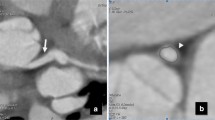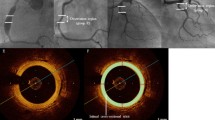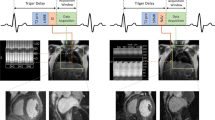Abstract
Coronary artery visibility on coronary CT angiography has rarely been investigated in young children with Kawasaki disease. This retrospective study was performed to quantitatively evaluate and compare coronary artery visibility with sufficient quality to measure it on coronary CT angiography among younger and older children with Kawasaki disease. Seventy-eight consecutive children with Kawasaki disease who underwent coronary CT angiography were divided into two groups: group 1 (age ≤ 6 years; n = 37) and group 2 (age > 6 years and < 18 years; n = 41). The visibility of the right coronary artery, left anterior descending artery, and left circumflex artery was quantitatively evaluated by dividing the length of the assessable coronary artery by the length of the corresponding groove, and compared between the two groups. The coronary artery visibility in group 1 was significantly lower than that in group 2 for the right coronary artery (77.8 ± 26.3% vs. 94.2 ± 13.6%, p < 0.002) and left anterior descending artery (54.8 ± 19.5% vs. 69.6 ± 21.3%, p < 0.003, but the difference was not significant for the left circumflex artery (43.7 ± 23.1% vs. 43.9 ± 26.7%, p > 0.9). In both groups, the visibility of the right coronary artery was the highest, followed by those of the left anterior descending artery and left circumflex artery. Compared with older children with Kawasaki disease, younger children with Kawasaki disease demonstrate significantly lower visibility of the right coronary artery and left anterior descending artery on coronary CT angiography. In contrast, the visibility of the left circumflex artery showed no significant difference between younger and older children with Kawasaki disease.

Similar content being viewed by others
References
Goo HW, Park IS, Ko JK, Kim YH (2006) Coronary CT angiography and MR angiography of Kawasaki disease. PediatrRadiol 36(7):697–705. https://doi.org/10.1007/s00247-006-0182-6
Dietz SM, Tacke CE, Kuipers IM, Wiegman A, de Winter RJ, Burns JC, Gordon JB, Groenink M, Kuijpers TW (2015) Cardiovascular imaging in children and adults following Kawasaki disease. Insights Imaging 6(6):697–705. https://doi.org/10.1007/s13244-015-0422-0
Tsuda E, Singhal M (2018) Role of imaging studies in Kawasaki disease. Int J Rheum Dis 21(1):56–63. https://doi.org/10.1111/1756-185X.13210
Goo HW (2015) Coronary artery imaging in children. Korean J Radiol 16(2):239–250. https://doi.org/10.3348/kjr.2015.16.2.239
Tangcharoen T, Bell A, Hegde S, Hussain T, Beerbaum P, Schaeffter T, Razavi R, Botnar RM, Greil GF (2011) Detection of coronary artery anomalies in infants and young children with congenital heart disease by using MR imaging. Radiology 259(1):240–247. https://doi.org/10.1148/radiol.10100828
Singh S, Sharma D, Bhattad S, Phillip S (2016) Recent advances in Kawasaki disease-proceedings of the 3rd Kawasaki disease summit, chandigarh, 2014. Indian J Pediatr. 83(1):47–52. https://doi.org/10.1007/s12098-015-1858-4
Singhal M, Gupta P, Singh S (2017) Khandelwal N (2017)Computed tomography coronary angiography is the way forward for evaluation of children with Kawasaki disease. Glob Cardiol Sci Pract 3:e201728. https://doi.org/10.21542/gcsp.2017.28
Singhal M, Singh S, Gupta P, Sharma A, Khandelwal N, Burns JC (2018) Computed tomography coronary angiography for evaluation of children with Kawasaki disease. Curr Probl Diagn Radiol 47(4):238–244. https://doi.org/10.1067/j.cpradiol.2017.09.013
Kim JW, Goo HW (2013) Coronary artery abnormalities in Kawasaki disease: comparison between CT and MR coronary angiography. Acta Radiol 54(2):156–163. https://doi.org/10.1258/ar.2012.120484
Tsai IC, Lee T, Chen MC, Fu YC, Jan SL, Wang CC, Chang Y (2007) Visualization of neonatal coronary arteries on multidetector row CT: ECG-gated versus non-ECG-gated technique. Pediatr Radiol 37(8):818–825. https://doi.org/10.1007/s00247-007-0512-3
Ben Saad M, Rohnean A, Sigal-Cinqualbre A, Adler G, Paul JF (2009) Evaluation of image quality and radiation dose of thoracic and coronary dual-source CT in 110 infants with congenital heart disease. Pediatr Radiol 39(7):668–676. https://doi.org/10.1007/s00247-009-1209-6
Goo HW, Yang DH (2010) Coronary artery visibility in free-breathing young children with congenital heart disease on cardiac 64-slice CT: dual-source ECG-triggered sequential scan vs single-source non-ECG-synchronized spiral scan. PediatrRadiol 40(10):1670–1680. https://doi.org/10.1007/s00247-010-1693-8
Paul JF, Rohnean A, Elfassy E, Sigal-Cinqualbre A (2011) Radiation dose for thoracic and coronary step-and-shoot CT using a 128-slice dual-source machine in infants and small children with congenital heart disease. Pediatr Radiol 41(2):244–249. https://doi.org/10.1007/s00247-010-1804-6
Duan Y, Wang X, Cheng Z, Wu D, Wu L (2012) Application of prospective ECG-triggered dual-source CT coronary angiography for infants and children with coronary artery aneurysms due to Kawasaki disease. Br J Radiol 85(1020):e1190–e1197. https://doi.org/10.1259/bjr/18174517
Jahnke C, Paetsch I, Schnackenburg B, Bornstedt A, Gebker R, Fleck E, Nagel E (2004) Coronary MR angiography with steady-state free precession: individually adapted breath-hold technique versus free-breathing technique. Radiology 232(3):669–676. https://doi.org/10.1148/radiol.2323031225
Uribe S, Hussain T, Valverde I, Tejos C, Irarrazaval P, Fava M, Beerbaum P, Botnar RM, Razavi R, Schaeffter T, Greil GF (2011) Congenital heart disease in children: coronary MR angiography during systole and diastole with dual cardiac phase whole-heart imaging. Radiology 260(1):232–240. https://doi.org/10.1148/radiol.11101659
Piccini D, Monney P, Sierro C, Coppo S, Bonanno G, van Heeswijk RB, Chaptinel J, Vincenti G, de Blois J, Koestner SC, Rutz T, Littmann A, Zenge MO, Schwitter J, Stuber M (2014) Respiratory self-navigated postcontrast whole-heart coronary MR angiography: initial experience in patients. Radiology 270(2):378–386. https://doi.org/10.1148/radiol.13132045
Nezafat M, Henningsson M, Ripley DP, Dedieu N, Greil G, Greenwood JP, Bӧrnert P, Plein S, Botnar RM (2016) Coronary MR angiography at 3T: fat suppression versus water-fat separation. MAGMA 29(5):733–738. https://doi.org/10.1007/s10334-016-0550-7
Heer T, Reiter S, Trißler M, Höfling B, von Knobelsdorff-Brenkenhoff F, Pilz G (2017) Effect of nitroglycerin on the performance of MR coronary angiography. J Magn Reson Imaging 45(5):1419–1428. https://doi.org/10.1002/jmri.25483
Goo HW (2010) State-of-the-art CT imaging techniques for congenital heart disease. Korean J Radiol 11(1):4–18. https://doi.org/10.3348/kjr.2010.11.1.4
Goo HW (2011) Individualized volume CT dose index determined by cross-sectional area and mean density of the body to achieve uniform image noise of contrast-enhanced pediatric chest CT obtained at variable kV levels and with combined tube current modulation. Pediatr Radiol 41(7):839–847. https://doi.org/10.1007/s00247-011-2121-4
Tricarico F, Hlavacek AM, Schoepf UJ, Ebersberger U, Nance JW Jr, Vliegenthart R, Cho YJ, Spears JR, Secchi F, Savino G, Marano R, Schoenberg SO, Bonomo L, Apfaltrer P (2013) Cardiovascular CT angiography in neonates and children: image quality and potential for radiation dose reduction with iterative image reconstruction techniques. Eur Radiol 23(5):1306–1315. https://doi.org/10.1007/s00330-012-2734-5
Goo HW, Allmendinger T (2017) Combined ECG- and respiratory-triggered CT of the lung to reduce respiratory misregistration artifacts between imaging slabs in free-breathing children: initial experience. Korean J Radiol 18(5):860–866. https://doi.org/10.3348/kjr.2017.18.5.860
Goo HW (2018) Combined prospectively electrocardiography- and respiratory-triggered sequential cardiac computed tomography in free-breathing children: success rate and image quality. Pediatr Radiol 48(7):923–931. https://doi.org/10.1007/s00247-018-4114-z
Goo HW (2012) CT radiation dose optimization and estimation: an update for radiologists. Korean J Radiol 13(1):1–11. https://doi.org/10.3348/kjr.2012.13.1.1
Gebhard C, Fuchs TA, Stehli J, Gransar H, Berman DS, Budoff MJ, Achenbach S, Al-Mallah M, Andreini D, Cademartiri F, Callister TQ, Chang HJ, Chinnaiyan KM, Chow BJ, Cury RC, Delago A, Gomez MJ, Hadamitzky M, Hausleiter J, Hindoyan N, Feuchtner G, Kim YJ, Leipsic J, Lin FY, Maffei E, Pontone G, Raff G, Shaw LJ, Villines TC, Dunning AM, Min JK, Kaufmann PA (2015) Coronary dominance and prognosis in patients undergoing coronary computed tomographic angiography: results from the CONFIRM (COronary CT Angiography EvaluatioN For Clinical Outcomes: An InteRnational Multicenter) registry. Eur Heart J Cardiovasc Imaging 16(8):853–862. https://doi.org/10.1093/ehjci/jeu314
Yamasaki Y, Kawanami S, Kamitani T, Sagiyama K, Shin S, Hino T, Nagata H, Yabuuchi H, Nagao M, Honda H (2018) Patient-related factors influencing detectability of coronary arteries in 320-row CT angiography in infants with complex congenital heart disease. Int J Cardiovasc Imaging 34(9):1485–1491. https://doi.org/10.1007/s10554-018-1363-8
Okada M, Nakashima Y, Nomura T, Miura T, Nao T, Yoshimura M, Sano Y, Matsunaga N (2015) Coronary vasodilation by the use of sublingual nitroglycerin using 64-slice dual-source coronary computed tomography angiography. J Cardiol 65(3):230–236. https://doi.org/10.1016/j.jjcc.2014.05.012
Watanabe H, Kamiyama H, Kato M, Komori A, Abe Y, Ayusawa M (2018) Appropriate use of a beta-blocker in paediatric coronary CT angiography. Cardiol Young 28(10):1148–1153. https://doi.org/10.1017/S104795111800118X
Rigsby CK, deFreitas RA, Nicholas AC, Leidecker C, Johanek AJ, Anley P, Wang D, Uejima T (2010) Safety and efficacy of a drug regimen to control heart rate during 64-slice ECG-gated coronary CTA in children. Pediatr Radiol 40(12):1880–1889. https://doi.org/10.1007/s00247-010-1711-x
Hong SH, Goo HW, Maeda E, Choo KS, Tsai IC, Asian Society of Cardiovascular Imaging Congenital Heart Disease Study Group (2019) User-friendly vendor-specific guideline for pediatric cardiothoracic computed tomography provided by the Asian Society of Cardiovascular Imaging Congenital Heart Disease Study Group: Part 1. Imaging techniques. Korean J Radiol 20(2):190–204. https://doi.org/10.3348/kjr.2018.0571
Meyersohn NM, Szilveszter B, Staziaki PV, Scholtz JE, Takx RAP, Hoffmann U, Ghoshhajra BB (2017) Coronary CT angiography in the emergency department utilizing second and third generation dual source CT. J Cardiovasc Comput Tomogr 11(4):249–257. https://doi.org/10.1016/j.jcct.2017.03.002
Ochs MM, Siepen FAD, Fritz T, Andre F, Gitsioudis G, Korosoglou G, Seitz S, Bogomazov Y, Schlett CL, Sokiranski R, Sommer A, Gückel F, Brado M, Kauczor HU, Görich J, Friedrich MGW, Katus HA, Buss SJ (2017) Limits of the possible: diagnostic image quality in coronary angiography with third-generation dual-source CT. Clin Res Cardiol 106(7):485–492. https://doi.org/10.1007/s00392-017-1077-2
Goh YG, Ong CC, Tan G, Liang CR, Soomar SM, Terence Lim CW, Quek SC, Teo LSL (2018) Coronary manifestations of Kawasaki Disease in computed tomography coronary angiography. J Cardiovasc Comput Tomogr 12(4):275–280. https://doi.org/10.1016/j.jcct.2017.12.003
Chen PT, Lin MT, Chen YS, Chen SJ, Wu MH (2017) Computed tomography predict regression of coronary artery aneurysm in patients with Kawasaki disease. J Formos Med Assoc 116(10):806–814. https://doi.org/10.1016/j.jfma.2017.07.001
van Stijn-Bringas DD, Planken RN, Groenink M, Streekstra GJ, Kuijpers TW, Kuipers IM (2020) Coronary artery assessment in Kawasaki disease with dual-source CT angiography to uncover vascular pathology. Eur Radiol 30(1):432–441. https://doi.org/10.1007/s00330-019-06367-6
Author information
Authors and Affiliations
Corresponding author
Ethics declarations
Conflict of interest
All authors declare that they have no financial or non-financial conflict of interest.
Ethical approval
All procedures performed were in accordance with the ethical standards of the institutional research committee and with the 1964 Helsinki declaration and its later amendments or comparable ethical standards.
Additional information
Publisher's Note
Springer Nature remains neutral with regard to jurisdictional claims in published maps and institutional affiliations.
Rights and permissions
About this article
Cite this article
Goo, H.W. Quantitative evaluation of coronary artery visibility on CT angiography in Kawasaki disease: young vs. old children. Int J Cardiovasc Imaging 37, 1085–1092 (2021). https://doi.org/10.1007/s10554-020-02054-6
Received:
Accepted:
Published:
Issue Date:
DOI: https://doi.org/10.1007/s10554-020-02054-6




